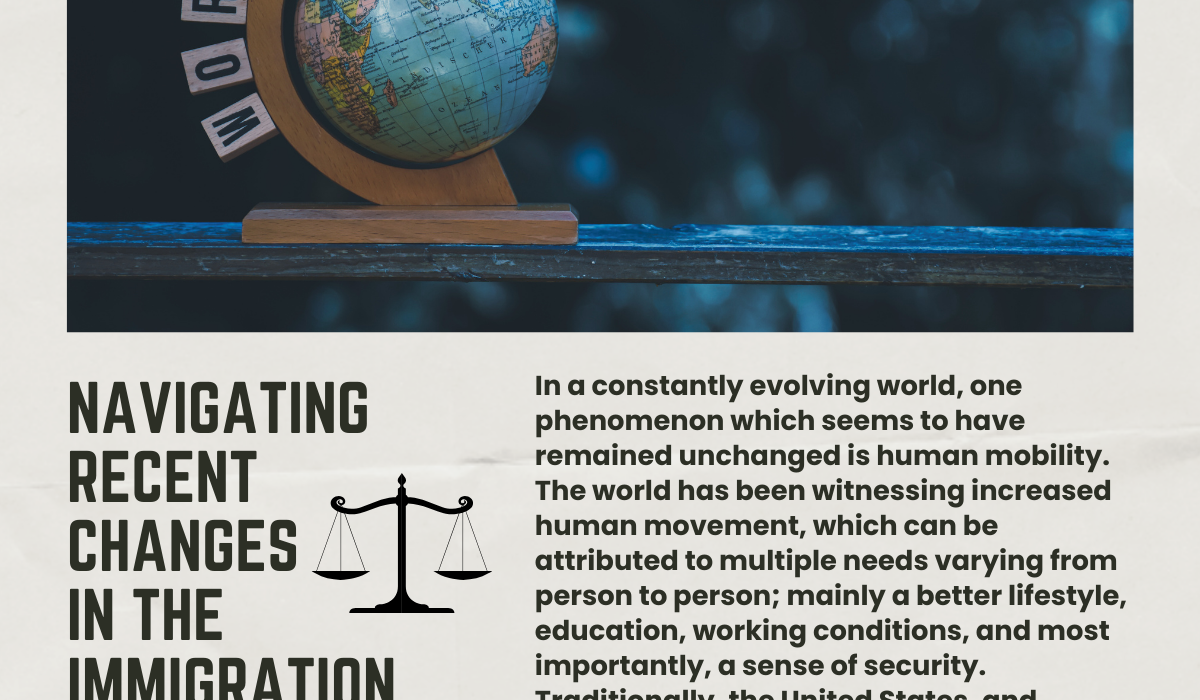NAVIGATING RECENT CHANGES IN THE IMMIGRATION SCENARIO: WHAT LIES AHEAD?
Introduction
In a constantly evolving world, one phenomenon which seems to have remained unchanged is human mobility. The world has been witnessing increased human movement, which can be attributed to multiple needs varying from person to person; mainly a better lifestyle, education, working conditions, and most importantly, a sense of security. Traditionally, the United States, and Commonwealth nations like Canada, The United Kingdom, and Australia have been the top choices for immigrants, particularly those of South Asian origin. Their consistent favourability of some of these countries can be attributed to multiple factors, such as cultural diversity, ease in obtaining permanent residence, openness towards expats, and high quality of education. However, neither does this seem to be the case anymore, nor are these options viable in the longer run. The author, by way of this article, aims to shed light on the ever-evolving global immigration landscape, and the possible options for individuals looking to turn to migration in hopes of advancing their career or achieving a better lifestyle.
Historically Preferred Destinations for Immigrants: An Overview
The Commonwealth nations, along with the United States, have long been the crowd favourites when it comes to migration. For the unversed, the United Statesis the world’s most popular destination eyed by migrants; with the primary reason being career advancement and access to so called state of the art infrastructure, education, and healthcare services. However, the US is also notorious for years’ worth of waiting times, complexity-ridden routes to obtain visas, and exorbitant investment amounts. This brings us to the Commonwealth nations, more so Canada, The UK, and Australia. These nations are well-known for fostering cultural diversity and provide a welcoming environment for expats. They are also popular among international students by virtue of the presence of some of the best universities and institutes of higher education. As a matter of fact, Canada houses more than 1 million international students, followed by the UK at 750,000 and Australia at nearly 720,000. It also becomes crucial to note at this juncture that most, if not all immigrants move to countries like Canada and Australia only due to the fact that they are known to offer easier routes to temporary, and eventually, permanent residence. Hence, it ensures an almost sure shot way to prolonged periods of residency and a chance at achieving a better quality of life.
Interestingly, the key factor contributing towards the influx of immigrants is the implementation of favourable immigration policies by the respective governments, along with the wide-spread usage of the English language. The implementation of the aforesaid immigration policies, however, is a culmination of multiple factorswhich are in a way, interdependent, and have been elaborated upon as under:
- Tackling Labour Shortage
The aforementioned countries have historically suffered from labour shortage, and hence introduced favourable migration policies for skilled and unskilled workers from across the world. For instance, the UK’s immigrant influx was marked by migrant workers taking on the jobs which a normal Briton was unwilling to do.
- Contribution to Economic Development
By devising policy framework targeted at highly skilled individuals, host countries, despite having no strong industry of their own, can leverage the expertise possessed by highly skilled migrants in sectors like IT. This led to innovation, scalability, and eventually the growth of the economy at one point in time. Moreover, immigrants may end up making a destination more lucrative from the point of view of a foreign investor.
- Ageing Population
Historically speaking, countries like Canada and Australia, which have an ageing population, have in the long run, benefitted from immigration by preventing a decline in the labour force. Immigration has also helped in preventing under-population and has subsequently maintained a stable age ratio.
The Onset of Changes in the Global Immigration Landscape
With the world evolving at a rapid pace, the domain of immigration has not been immune to change. While governments became more welcoming, subsequently leading to a boom in immigration towards the end of the 20th century, that no longer seems to be the case. The event which was the starting point for more stringent immigration policies was the Attack of September 11, popularly known as 9/11. The United States of America, in an attempt to crack down on terrorism, enforced multiple preventative measures including enhanced border security, significant increase in deportations, higher investment amounts for entrepreneurs looking to use the EB-5 route, and more stringent criteria for obtaining student and work visas (particularly the H-1B Visa). It is safe to say that the immigration crisis has only worsened since the Covid-19 pandemic; not just in USA, but across all ‘developed’ nations. The Commonwealth nations too, are no strangers to the woes brought about by the influx of immigrants. More particularly, Canada has introduced significant changes to its otherwise liberal policy by capping the maximum number of worker and student visas which may be issued on an annual basis. As opposed to 485,000 in 2024, Canada is set to accept 10% lesser international students in the next couple of years. Post Graduates, who were previously exempt from the cap will now be subjected to the same. Similarly, Australia too, has brought about significant changes to its student and worker visa policies, which now stipulate higher rejection rates for first time applicants, increased visa application fees, as well as an increase in the minimum amount required to be demonstrated as proof of financial sufficiency.
Independent of the terrorism factor, the aforementioned countries, along with the European Union are limiting the number of legitimate entry routes for immigrants. Further, with more and more far-right organizations coming into power, the general public’s perception immigrants is souring with each passing day. The United Kingdom, in particular, witnessed multiple anti-immigrant riots earlier this year. As for the United States, its immigration policy is anticipated to become even more stringent in the event that former president and Republican nominee Donald Trump returns to power for a second term.
The rapidly changing landscape of immigration policiescan be attributed to the following, among other factors:
- Illegal and Undocumented Migration: With economic and political instability plaguing multiple nations across the world, people often turn to illegal routes to migrate to another nation in hopes of a better tomorrow for themselves and their families. The entry of undocumented immigrants not only burdens the public systems, but also leads to worker exploitation, and eventually increased crime rates.
- Deteriorating Education System: One of the major cons of highly liberalised immigration policies is the exploitation of students through scholarship scams and fake university scams wherein they are prompted to apply for visas upon being presented with fake admission letters. This problem is particularly prevalent in Canada and the United States, and the former is actively trying to tackle this issue heads on by way of upcoming amendments to its immigration policy.
- Skyrocketing Real Estate Prices: An increase in the number of immigrants has the potential to increase the demand for housing, which in turn leads to higher prices. Moreover, artificial low interest rates are also to be blamed.
- Overburdened Healthcare System: Immigrants are more prone to face discrimination and xenophobia while trying to avail themselves of rather expensive healthcare services. However, there is more to the problem than just this. Apart from the affordability factor, the infrastructure of multiple host countries like The UK, USA, and Canada are overburdened, and marked by long waiting times and overwhelmed emergency rooms.
- RecedingEconomy: Though it is argued that immigration boosts the economy of a host country, what is often overlooked is the fact that low-skilled or unskilled migrant workers are often forced to take up jobs paying a fraction of the stipulated minimum wages. In the long run, this affects the GDP per capita, and subsequently the economy. Moreover, with most of the world facing an economic crisis in some shape or form, governments are now focused on prioritising employment for their own citizens, instead of migrant workers.
What Lies Ahead?
With most of the traditional destinations slowly closing their doors for immigrants, the first question that comes to mind is: “What’s next?” Regardless of the change in laws and policy framework, immigration is projected to witness a sharp uptick in the decades to come. Increased access to education, and search for better opportunities will be the driving factors herein. However, with the issuance of work and study visas set to be capped across multiple countries, the avenues for legal migration have become extremely limited.
The European Union, along with South America seem to be, at present, the most viable options for individuals looking to relocate to countries offering a dynamic business environment, openness towards expats, and high standards of living. Some countries in the European Union, like Portugal and Estonia offer easy pathways to long-term residency and citizenship for individuals engaged in innovative and high-revenue generating ventures. The most trustworthy pathways in this regard include the entrepreneur visa, the self-employed visa, and the start-up visa. Similarly, Brazil offers permanent residency by way of investment, through its VIPER visa.
Making a legitimate investment in a country and generating business out of it is any day a more reliable alternative for an individual looking to settle into, and explore a new territory. Moreover, with the rise of remote working and the introduction of digital nomad visas, people are no longer limited by borders, and can facilitate the rise of a more inter-connected world. In a nutshell, the opportunities are endless!
Conclusion
With many of the immigration reforms still being under the stage of implementation and execution, their exact extent of their impact on human mobility and existing temporary residents is yet to be fully realised. However, readers may keep in mind that these changes do not signal towards the end of their dreams of achieving a better lifestyle. With the world no longer being limited by boundaries, the opportunities are endless. As discussed earlier, making sound and strategic investments in the right set of ventures now seems to be the most viable pathway to residency. Regardless, it will be interesting to see how things pan out in the years to come.
Authored by:
Priyamvada Lonial, Advocate, SUO Law Offices



